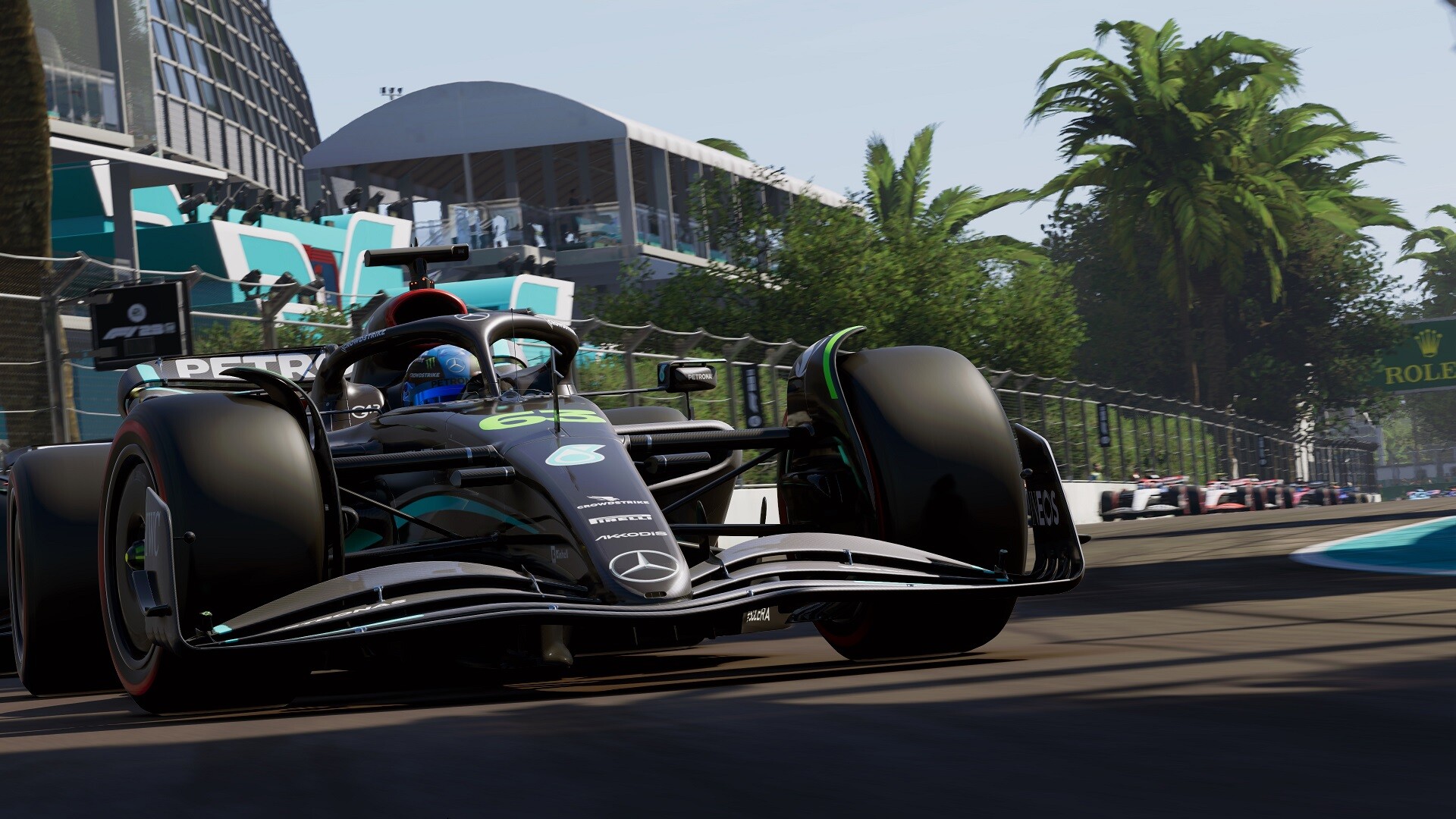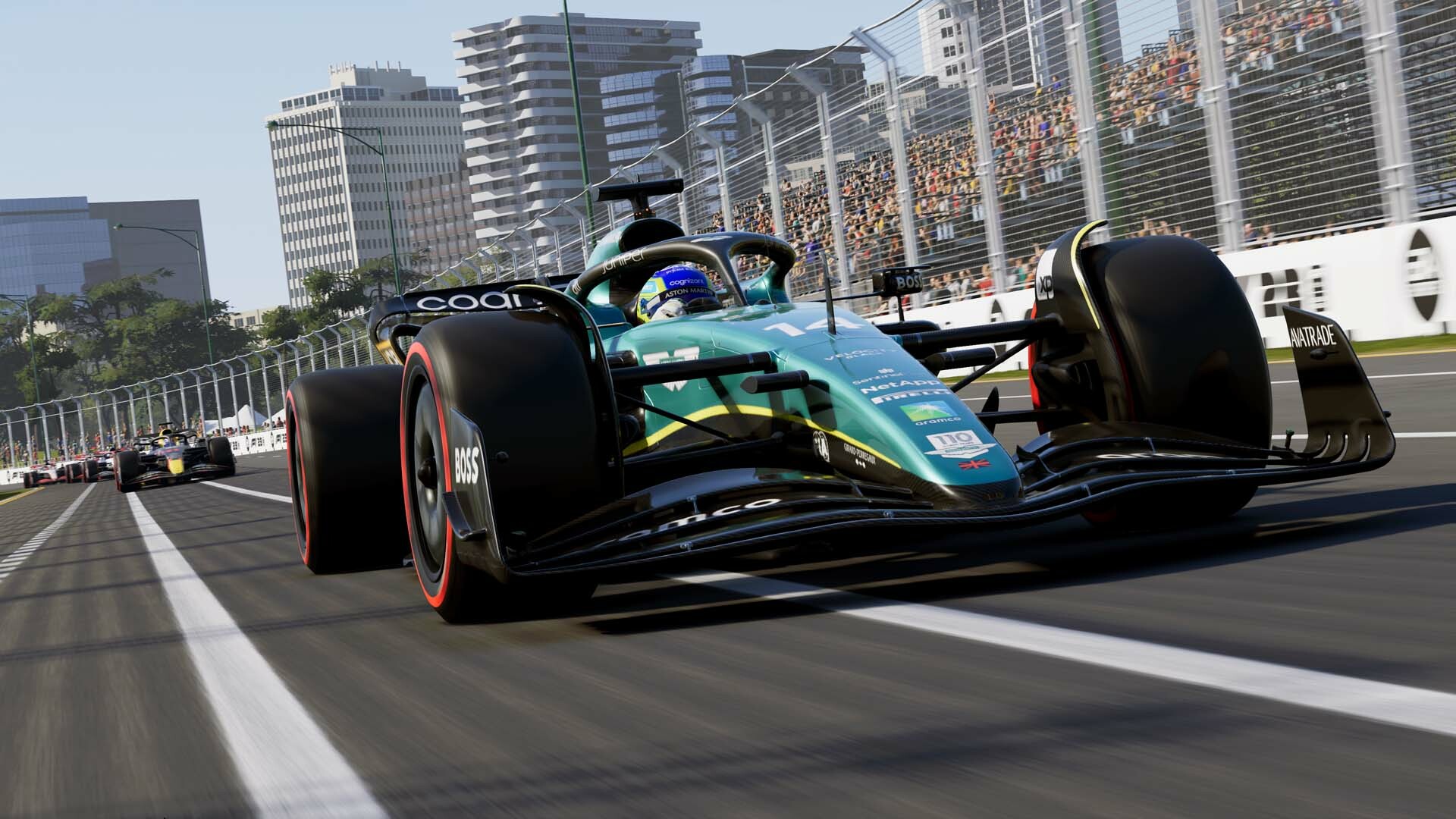
The level of consistency that Codemasters has displayed with the F1 franchise over the years has been hugely impressive, with the racing sim franchise making significant improvements to its already excellent foundation year over year, and with the upcoming F1 23, it very much looks like that trend will continue. From physics improvements and the new Precision Drive technology to the reintroduction of red flags, the game is promising meaningful on-track improvements, while off it, the headlining addition of F1 World and the much-anticipated return of F1 2021’s story mode, Braking Point, are also elements to be excited about. F1 23’s launch is imminent now, and players will soon be going hands-on with it themselves, but ahead of that, we recently reached out to its developers with a few of our questions about the game. Below, you can read our interview with senior creative director Lee Mather.
F1 23 is bringing back Braking Point, which was a particularly beloved addition upon its introduction in F1 2021. Was it always the plan to bring back the mode after a year’s break? Did the requirements of developing a full-fledged narrative-driven mode demand an additional development year?
Due to the way in which the development team is structured, we have two teams who work on the odd and even year titles in the franchise. The team who worked directly on F1 2021 were obviously well suited to that type of game mode. That was one of the considerations for the feature being bi-annual. Other considerations were that in order to deliver a fully featured and visually engaging story mode, we needed more time. Crafting something on the scale of Breaking Point 2 requires a significant amount of resource, both internally and externally. If you consider F1 2020 or F1 22, there wouldn’t be the requirement for the beautiful cut scenes or characters. Plus, with us having two titles in development at the same time, we plan several years ahead in order to ensure we have the right people in place to execute on our vision. Obviously we make adjustments along the way, but the overall vision for the series is in place.
What sort of improvements should players expect from Braking Point 2? For instance, how significantly will players’ choices impact the story?
Increasing player agency was at the core of the changes we wanted to make to the gameplay side of Braking Point 2. We achieved this with the inclusion of Performance and Reputation levels for the player. These are impacted by their on-track conduct as well as how they perform in media interviews or the team management decisions they make. The impact of these new elements will generate different outcomes, goals and open up rewards for players as part of the secondary narrative.
Another headlining addition in F1 23 is F1 World, a multifaceted hub of sorts that’ll be tying the whole experience together? What prompted the decision to introduce something like this in the F1 series?
We’re incredibly excited about the inclusion of F1 World. The concept behind F1 World is to be able to deliver an ever changing roster of content and gameplay to the player over the course of the entire season. Braking Point 2 offers Drive to Survive style cinematic drama, Career offers authenticity and My Team offers players authenticity and team management. We also have great game modes such as Time Trial, Grand Prix, Events and multiple ways to play online. With F1 World we wanted to take these game modes and bring them together with a new and engaging progression system which encompasses both Offline and Online play. This is where the concept of earning resources to upgrade your F1 World car is at the core of F1 World. Offering the player multiple ways to enjoy F1 content, in styles of gameplay which appeals to them, with a time commitment which they’re comfortable with is why F1 World can cater to that free half an hour you might have after dinner, all the way up to completing 100% race distances.
We also saw F1 World as a great opportunity to expand our Multiplayer experience. Alongside the existing Multiplayer Grand Prix lobby based system, players will now be able to race in Multiplayer events. We’ve also included an entirely new Ranked Multiplayer mode. Each week players will compete on a fixed roster of circuits to achieve promotion or avoid demotion between several Bronze, Silver and Gold leagues. There’s also the pinnacle of racing performance with an Elite League where the best in the world will compete.
For those who play F1 games frequently over a prolonged period, F1 World’s new progression system sounds particularly intriguing. How extensive will this system be? What level of variety should players expect from what they’ll be able to unlock through the new progression mechanics?
It’s great that you’ve identified that F1 World will deliver players new and changing experiences over the year. That’s the core of the concept, to keep delivering exciting and engaging gameplay for our players.
As I touched upon in the previous question, F1 World features a new F1 World car which the player will upgrade to increase its performance. Performance is rated by a ‘Tech Level’. Players are able to enter events with higher and lower tech level requirements to set the level of challenge they’re looking for. Playing any of the modes within F1 World will earn the player resources which can then be used to directly upgrade the car, or be used to craft further upgrades and enhancements. In F1 World the player will not only be upgrading the car itself, but also team personnel and the contract benefits which they bring.
We also wanted players to be closer to the world of F1, which is where the Compendium comes in. The Compendium acts as a sticker album which the player can fill up as they’re awarded stickers as prizes. As images are completed, the Compendium will fill up and offer players interesting and engaging content related to the world of F1.
F1 games have a reputation for their incredible attention to detail in recreation licensed circuits. What can you tell us about the two new additions in this year’s game, and what the process of designing them was like?
We love years where there are new circuits on the calendar. This year we have two circuits which couldn’t be more different from one another.
Lusail in Qatar was originally built for MotoGP back in 2004 but is a tremendous circuit to showcase the speed and downforce of a modern F1 car. The corners are fast and flowing and will offer racers some great wheel-to-wheel overtaking moments. We modeled the Lusail circuit from Formula One supplied Computer Aided Design (CAD) data, aerial imagery, height data and a high amount of photogrammetry in order to create an accurate virtual representation of this new circuit.
Las Vegas on the other hand offers a totally different prospect. Joining the calendar as the 3rd circuit in the United States, Las Vegas is an intense street circuit which takes in one of the most famous pieces of tarmac in the world, the Las Vegas boulevard. With the circuit still under construction right now, the in-game Vegas circuit will be the first time players and drivers alike get to experience the new track. The most significant challenge when creating Las Vegas was the sheer density of buildings, plus our want to ensure they’re an accurate visual representation of their real world counterparts. Vegas is also unique in that the race is taking place on the Saturday evening. This brough new lighting challenges. As anyone familiar with Las Vegas would know, the strip is a huge colorful and bright visual spectacle.
What can you tell us about the game’s physics improvement and what sort of an impact they will have on the moment-to-moment driving experience?
We’ve made significant gains across several areas of our vehicle physics. Starting with the point at which the rubber meets the road, literally, we worked on our tyre model, making changes to the relationship between longitudinal and lateral slip which had a significant impact on how the car breaks and regains traction or behaves in a slide. We also did work on the wheel and body inertia calculations which also impact how the car rotates and behaves. To further aid drivability and enhance realism we also carried out significant work on our in-gear engine torque properties. This allows for a far more controlled and realistic level of fidelity when applying the throttle and controlling wheelspin. Finally we took data supplied to us by one of the F1 teams to help us balance the relationship between aero and mechanical grip.
All of these changes have allowed us to deliver a more realistic, engaging and controllable handling model.
What will the addition of the new Precision Drive technology bring to the table?
The core concept behind Precision Driver was to give controller players an enhanced level of control and fidelity to bring them in line with wheel players. Wheel users are able to make small and accurate adjustments which aren’t as easy on a controller. Precision Drive opens up this level of control. The system also allows players to be able to effectively navigate corners of differing types. We’ve also expanded the options available to allow controller users to be able to tune the system to the rate of input which suits how they play.
F1 23 is also introducing a number of new features based on community feedback, like a new race distance and the return of red flags. What can you tell us about those changes? How much does feedback from players shape your decisions during a game’s development?
Community feedback has always played a significant role in the development of the F1 series. We maintain a backlog of conversations as well as receive regular updates from several teams within EA who monitor our social channels and forums.
The 35% race distance was a change we trialled during the F1 esports series. We found that it offered a sweet spot for time commitment, but also provided a great representation of the strategy elements of an F1 race.
Red Flags have long been a requested feature, and they’ve been on our list of features to extend authenticity in the series. The inclusion of Red Flags in F1 23 will not only reinforce the level of realism but will also play a significant impact in changing the course of a race. During a Red Flag stoppage players will be able to make minor repairs to their vehicle as well as changing tyres and strategy all of which can significantly impact the story of the race.
F1 23 is bringing back VR support on PC, though PS VR2 support won’t be featured at launch. Is that something you might look into following the game’s release?
At this stage we’re solely focused on VR support for PC. We continue to discuss it as a team, but it’s not something we’re currently working on.

















